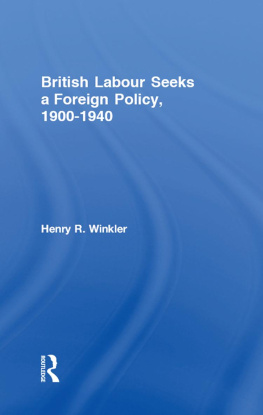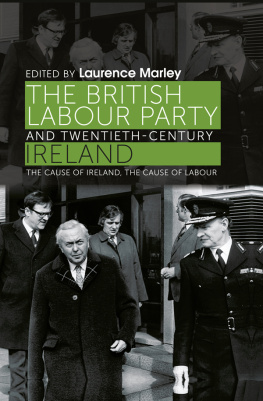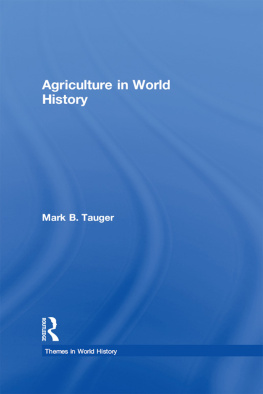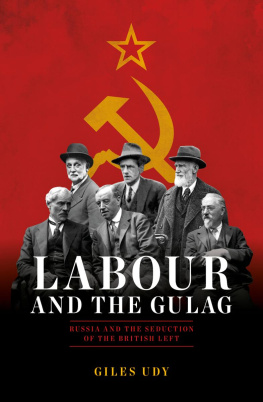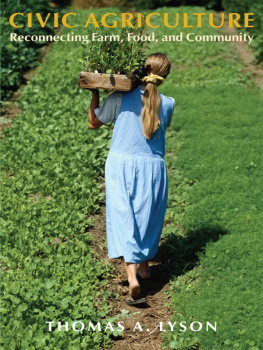ROUTLEDGE LIBRARY EDITIONS: THE FIRST WORLD WAR
Volume 5
BRITISH AGRICULTURE IN THE FIRST WORLD WAR
BRITISH AGRICULTURE IN THE FIRST WORLD WAR
P. E. DEWEY
First published in 1989
This edition first published in 2014
by Routledge
2 Park Square, Milton Park, Abingdon, Oxon, OX14 4RN
and by Routledge
711 Third Avenue, New York, NY 10017
Routledge is an imprint of the Taylor & Francis Group, an informa business
1989 Peter E. Dewey
All rights reserved. No part of this book may be reprinted or reproduced or utilised in any form or by any electronic, mechanical, or other means, now known or hereafter invented, including photocopying and recording, or in any information storage or retrieval system, without permission in writing from the publishers.
Trademark notice: Product or corporate names may be trademarks or registered trademarks, and are used only for identification and explanation without intent to infringe.
British Library Cataloguing in Publication Data
A catalogue record for this book is available from the British Library
ISBN: 978-0-415-74924-4 (Set)
eISBN: 978-1-315-77961-4 (Set)
ISBN: 978-1-138-01433-6 (Volume 5)
eISBN: 978-1-315-78092-4 (Volume 5)
Publishers Note
The publisher has gone to great lengths to ensure the quality of this reprint but points out that some imperfections in the original copies may be apparent.
Disclaimer
The publisher has made every effort to trace copyright holders and would welcome correspondence from those they have been unable to trace.
BRITISH AGRICULTURE IN THE FIRST WORLD WAR
P. E. DEWEY
First published in 1989 by
Routledge
11 New Fetter Lane, London EC4P 4EE
29 West 35th Street, New York NY 10001
1989 Peter E. Dewey
Printed in Great Britain by
T. J. Press (Padstow Ltd), Padstow, Cornwall
All rights reserved. No part of this book may be reprinted or reproduced or utilized in any form or by any electronic, mechanical, or other means, now known or hereafter invented, including photocopying and recording, or in any information storage or retrieval system, without permission in writing from the publishers.
British Library Cataloguing in Publication Data
Dewey, P. E. (Peter E), 1944
British agriculture in the First World War.
I. Great Britain. Agricultural industries, 19141918
I. Title
338.10941
Library of Congress Cataloging in Publication Data
Dewey, P. E., 1944
British agriculture in the First World War / P. E. Dewey.
p. cm.
Bibliography: p.
Includes index.
ISBN 0415026377
1. AgricultureGreat BritainMilitary aspects. 2. Great BritainHistoryGeorge V, 19101936. 3. World War, 191418Economic aspectsGreat Britain. I. Title.
HD1925.D49 1989
338.10941dc19
ISBN 0415026377
To Hilary
Most of the research on which this book is based was done whilst the author was in receipt of a postgraduate studentship from the Social Science Research Council (now the Economic and Social Research Council), whose assistance is gratefully acknowledged. The Central Research Fund of London University provided a research grant for the consultation of the minutes of War Agricultural Committees held in county record offices. The Isobel Thornley Bequest (London University) provided a grant to defray the cost of converting the authors word-processor discs into a suitable format for publication. I am glad to acknowledge the assistance of Somerset Record Office in granting permission to reproduce the document from the Somerset RO on p. 117, and Routledge for permission to reproduce the map on p. 205.
| AWB | Agricultural Wages Board |
| CPA | Corn Production Act (1917) |
| CP(A)A | Corn Production (Amendment) Act (1918) |
| DC | District Committee |
| DORA | Defence of the Realm Act |
| EC | County Agricultural Executive Committee |
| EO | Executive Officer |
| FPD | Food Production Department of the Board of Agriculture |
| IHC | International Harvester Company |
| WAC | County War Agricultural Committee |
| WLA | Womens Land Army |
| WWAC | Womens War Agricultural Committee |
The term billion signifies million million throughout.
The First World War posed enormous problems for the agricultural systems of the belligerent nations. In most cases, these problems were insurmountable. As labourers went off to war, and machinery, fertilisers, and horsepower became more scarce, the consequence was usually a substantial decline in production. This was particularly marked in the countries of central Europe such as Austria-Hungary and Germany, which were subject to blockade by the Entente powers. In continental Europe as a whole, agricultural production fell by about one-third.1 In these difficult circumstances, Britain has long been recognised as an exceptional success story. During the war, the supply of food was maintained almost intact. At its lowest point, in 1917, the calorie value of the average UK diet was only 4 per cent lower than in 190913.2
In assessing the reasons for this success, contemporaries and historians have emphasised the success of the food production policy implemented by the Lloyd George government in 191718. This aimed, by ploughing up grassland, to produce more food from home agriculture. The scientific rationale behind this policy was sound; for physiological reasons, more human food per acre of land can be produced if it is devoted to crops for direct human consumption rather than livestock. Large claims for the success of the plough policy were made after the war. These were put forward by Sir Thomas Middleton, who had been closely connected with the policy. His claim was that home agriculture increased food output in 1918 by 24 per cent over that of pre-war. In his view, this represented a signal success, which contributed to the satisfactory final result of maintaining food supplies.3
The policy of food production was widely felt to be successful, and provided the model for the policy of the Second World War, whose success is not in doubt. However, concentration on the policy of 191718 has led to a neglect of the history of British agriculture over the whole period of the war. One of the most compelling reasons for studying the period is that so far we have not known what British farmers actually produced during 191418. The first census of agricultural production was taken in 1908; the next one not until 1925. In between those dates we have to rely on the annual agricultural statistics, which have their limitations. This neglect of what was actually happening to agricultural production in 191418 has had two consequences; it makes it difficult to judge how effectively farmers coped with the wartime shortages of factors of production, and to judge the effectiveness of the plough policy in 191718.
The lack of a yardstick against which to set the performance of agriculture has led to confusion. This may be seen in the case of labour supply. Only in mid-1917 was farm labour fully protected against the demands of the Army. Thus until then, farmers could expect to lose a large proportion of their labour. The official view was that agriculture had lost about one-third of its labour by the end of 1916. This view was based on information whose validity we shall question. But it seems to have escaped notice at the time (and subsequently) that a loss of this magnitude, if true, had serious potential implications for production. To put it simply, how could farmers cope with a sudden loss of this size, and still maintain output?


